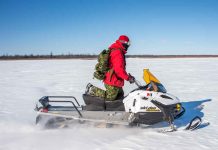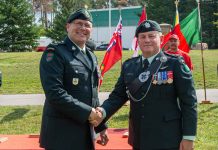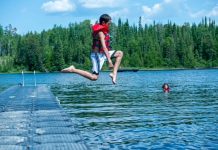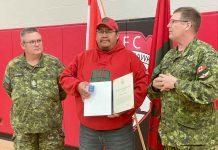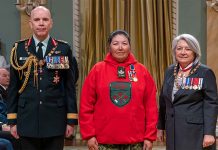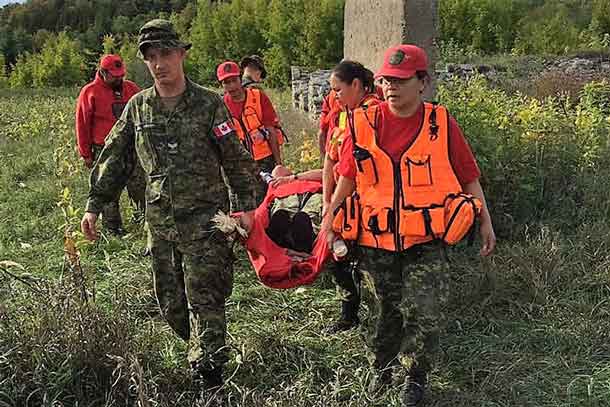
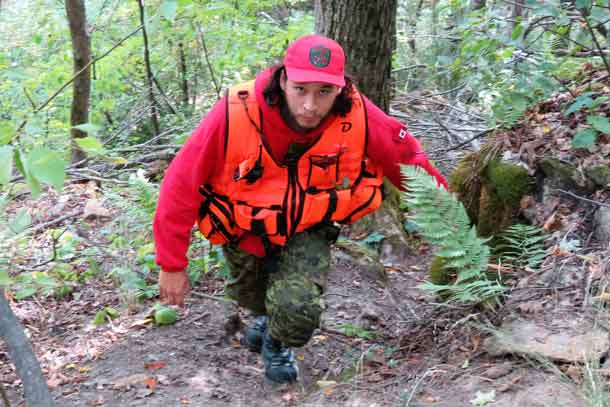
credit: Sergeant Peter Moon, Canadian Rangers.
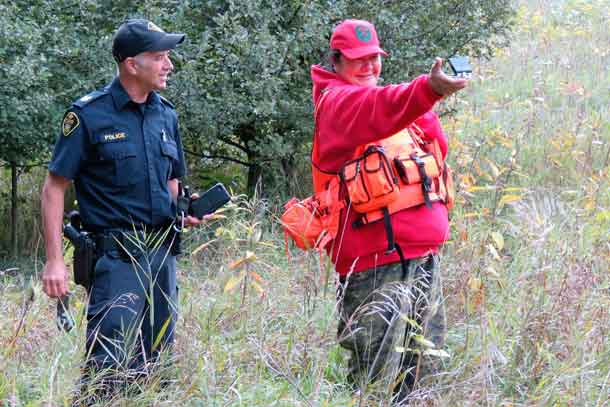

BEARSKIN LAKE – A Canadian Ranger search and rescue course produced a real emergency for its students when one of them broke her ankle and had to be carried on an improvised stretcher for more than a kilometre to get medical attention.
“They did a great job,” said Warrant Officer Barry Borton, a Canadian Army instructor. “The whole crew went to help her.”
Sergeant Mary Miles, commander of the Ranger patrol in Fort Severn, a small Cree community on Hudson Bay and Ontario’s most northerly community, twisted her foot in rough terrain in Mono Cliffs Provincial Park, near Orangeville, while navigating alone as part of an Ontario Provincial Police search and rescue course. As soon as the other eight students were alerted to her predicament they went to her rescue.
“The Rangers cut down a couple of trees to make poles and used t-shirts to make a stretcher,” Warrant Officer Borton said. “They carried her for 1.3-kilometres over rough ground to get her out to the road and then I was able to drive her to the hospital. She had a hairline fracture and a chipped bone.”
The accident happened during a 10-day course run by the OPP to train Canadian Rangers as OPP-qualified search and rescue operators.
The Rangers, who are part-time army reservists, play a key role in search and rescue operations in the Far North of Ontario, said Sergeant Jamie Stirling, the OPP’s provincial search and rescue co-ordinator. While the OPP has prime responsibility for ground search and rescue in Ontario, assembling an OPP emergency response team and getting a plane to fly it into a remote First Nation can take up to eight hours or longer depending on the weather. By then the Rangers, responding to an official request from the OPP for Canadian Army assistance, have usually found the missing person or persons.
“The Rangers are one of our number one search and rescue partners in the province,” Sergeant Stirling said. “They know their local territory where they live and they do a tremendous job for their communities in life and death situations.”
Sergeant Miles was one of nine students on the OPP course, which was held at Canadian Forces Base Borden. It was the first time there were more female Rangers than males on a course. Five of the nine students were female. “The women performed admirably,” Warrant Officer Borton said, “and to tell the truth some of them outperformed the guys.”
The demanding course consisted of classroom and field instruction and practical training, including night exercises, two of which did not end until midnight and a third that finished at 2 a.m.
“It’s been very challenging,” said Master Corporal Linda Kamenawatamin of Bearskin Lake, an isolated Oji-Cree community 425 kilometres north of Sioux Lookout. “I’m very tired. I wanted to give up but I knew I had to keep going on, so I kept going. I’m very proud of myself for what I’ve accomplished. I’ve learned a lot and I am the first Ranger from Bearskin to pass this course. I will be able to take back a lot to my community from this training. We have a lot of searches in my community.”
The Rangers now have OPP-qualified personnel in every one of their 20 patrols across Northern Ontario. More than 40 Rangers have completed the OPP training in the last six years. About a quarter are female.
“We see a lot of changes in the Rangers,” Sergeant Stirling said. “They are coming to us with an increased sense of purpose. They know that by coming they are going to be able to help their communities in emergencies. I ask them why they are here on the course and the overwhelming answer is they are here to help people who are lost. And the Rangers do that, very efficiently. They really do serve their communities.”
The students, all of whom graduated, were: Sergeant Mary Miles of Fort Severn; Master Corporals Emily Beardy of Muskrat Dam, Linda Kamenawatawin of Bearskin Lake, Joe Lazarus of Kashechewan, and Donovan Meeseetawageesic of Fort Hope; Corporals Marlene Chickekoo of North Caribou Lake and Myra Kanakakeesic of Sachigo Lake; and Rangers Brendan Sawanas of Sandy Lake and Kevin Smith of Sachigo Lake.
(Sergeant Peter Moon is the public affairs ranger for the 3rd Canadian Ranger Patrol Group at Canadian Forces Base Borden.)

